Your Cart is Empty
Menu
-
- Shop by Type
- End of Line Sale Items
- New In
- Viking Gifts Under $30
- Hand Forged Axes
- Silver Viking Jewelry
- Stainless Steel Jewelry
- Cremation Jewelry
- Necklaces and Pendants
- Hand Carved Wooden Pendants
- Kings Chains
- Viking Drinking Horns
- Pendant Chains
- Rings
- Bracelets
- Earrings
- Beard Beads and Beard Rings
- Collectables
- Ceramic Mugs
- Street Wear
- Horn Jewelry
- Bronze and Pewter Jewelry
- Shop by Theme
- Viking Axe
- Celtic Jewelry
- Dragon or Serpent
- Viking Raven
- Wolf / Fenrir
- Rune Jewelry
- Odin Jewelry
- Ram / Goat
- Shieldmaidens / Lagertha
- Sword, Spear or Arrow
- Thor's Hammer / Mjolnir
- Tree of Life / Yggdrasil
- Helm of Awe / Aegishjalmur
- Triquetra or Triskelion
- Valknut / Knot of Slain
- Vegvisir / Viking Compass
- Veles / Bear
- Blogs
- Help
-
- Login

Viking Jewelry - History and Uses

Viking and Norse-Era Jewelry
When you first think of ancient Vikings, their jewelry is probably not the first thing that springs to mind. Instead most people imagine bearded savages with long spears, swords, and heavy shields attacking defenceless coastal communities.
However, the Norse people of old, whilst being fearless warriors also made beautiful and intricate ornaments such as bracelets, rings and necklaces out of a variety of materials including bronze, iron, gold, silver, amber, and resin.
Early on in the Viking era (about 800 AD), these ornaments were simple, but as time went by, the pieces became more detailed and sophisticated.
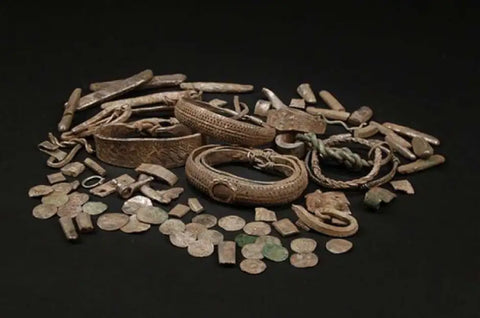
Group shot of the Silverdale Hoard finds. Image by Ian Richardson.
Viking Jewelry – Its Use and Purpose
Both men and women of the Viking community wore a wide variety of jewelry that added some much needed glamour to their seemingly dark world, but Viking jewelry also had a secondary purpose – it was used as currency in trade, which is probably why the Vikings preferred to use mainly precious metals to craft their jewelry.If an ornament was too large or valuable for a particular transaction, the piece would be broken into smaller chunks to suit that particular deal. If you think about it, the Vikings used their jewelry much like we use modern-day notes and coins today.
However, not all Viking jewelry was made from metal; the Norsemen also created beautiful ornaments using beads and precious rocks and stones, although it was rare for the Vikings to inset stones in their jewelry even though this art form had been applied before the Viking age.
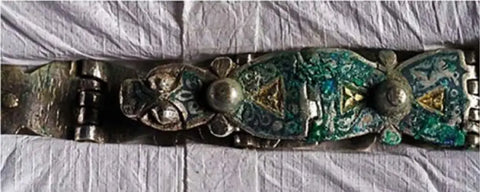
A hinged silver strap ( Robert Clark, National Geographic / Historic Environment Scotland ).
Viking Necklaces
The Vikings crafted their necklaces from a variety of items including metals such as silver, gold and bronze. They also employed natural fibres and iron wires of various lengths and sizes.
The necklaces would normally be accompanied by pendants made from glass beads, precious stones, resin, amber (from the Baltic sea), and small metallic charms. However, the most common material for necklace pendants was glass which would be mass produced for this purpose. The pendants on the necklaces were often souvenirs, gifts, or Nordic religious symbols that held meaning to the wearer.
In addition to wearing necklaces the Viking also occasionally wore neck-rings. Neck-rings that have been discovered across Europe were made of silver, bronze, or gold and most have been discovered in hoards rather than grave sites making it difficult to say exactly which gender wore them. However, most historians believe that neck-rings were worn by both genders as a display of wealth and as a form of currency in commercial transactions. They were designed and crafted in standard units of weight in order to make the assessment of value more accurate. As mentioned above, a piece would potentially be cut from the neck-ring depending on the amount necessary to conclude a commercial transaction.
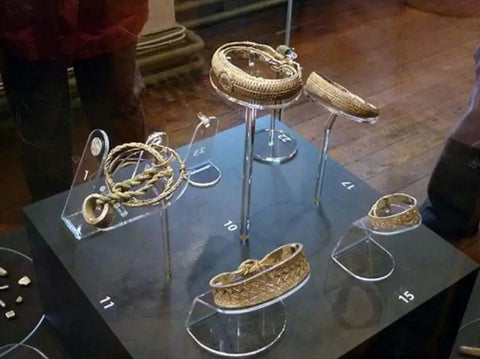
The Silverdale Hoard, Lancaster Museum. Neck-rings, arm-rings and necklace.
Viking Pendants and Amulets
The pendant is the decorative piece hung from the chain of a necklace. The most common pendants used in Viking necklaces were the Mjolnir or Thor’s Hammer, the Valknut and the Yggdrasil or Tree of Life. Of these, the Thor’s Hammer pendant appears to be the most frequently worn of them all. Other examples include miniature weapons such as axes and arrow heads, perforated coins and crosses however these have been found in only a few graves, suggesting that they were not commonly worn.
You may wonder why a pagan community would wear crosses but even at the height of the Viking era, Christian missionaries were still converting Vikings in small numbers and consequently some Norsemen adopted this new religion, forming a hybrid system of belief.

Left to right: Thor's hammer necklace from Bredsättra, Sweden. Mjolnir pendant from Rømersdal, and a copy of the Thor's hammer necklace from Skåne
Beads
Viking bead ornaments were typically made of amber or glass and were some of the most common additions to necklaces and were also worn as beard jewelry and beard beads. In today’s world these items are relatively cheap and widely used, but archaeological evidence from Viking grave sites suggests that these ornaments were rare and not worn by many.Moreover, even the Viking ornaments with beads only had one, two, or three of them, either worn alone or with an additional pendant such as a Mjolnir.
Finding more than three beads on a necklace is extremely rare, which suggests that they were precious and valuable, and perhaps symbolized one’s wealth and status in society.
Additionally, seeing as archaeological findings usually found only 1 to 3 beads on necklaces, it is quite possible that the number of beads a person wore represented more than just wealth and societal status and may have signified a certain level of achievement or age. A majority of beads found in archaeological sites were made of glass; other materials such as jet and amber have also been discovered but are rarer to come by.
Brooches
Brooches were very popular in Viking culture and were an everyday essential item used for holding clothes in place. Brooches came in a number of styles with the main ones being the Penannular Brooches and Oval Brooches .
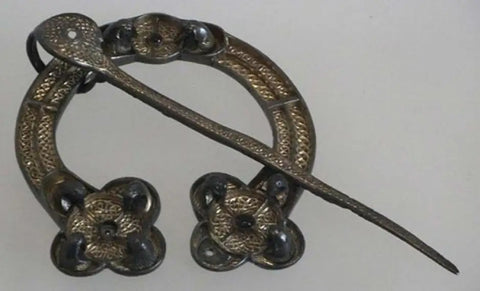
Example of a Celtic Penannular brooch, Museum of Scotland.
The Penannular brooch was exclusively worn by Viking men and was adopted by the Vikings from Scottish and Irish settlers with the trend later catching on in Russia and Scandinavia. Brooches would be fastened on the wearer’s right shoulder with the pin facing upward, which left the sword-arm free.
The Oval brooch, on the other hand, was typically worn by Viking women. Oval brooches were used to fasten dresses, aprons, and cloaks and were more detailed and ornate in comparison to penannular brooches. A single brooch would be worn on the shoulder to fasten the wearer’s dress, along with a chain of colored beads for added visual appeal. Oval brooches are believed to have gone out of fashion at around 1000 AD and were replaced by more fanciful designs of brooches.
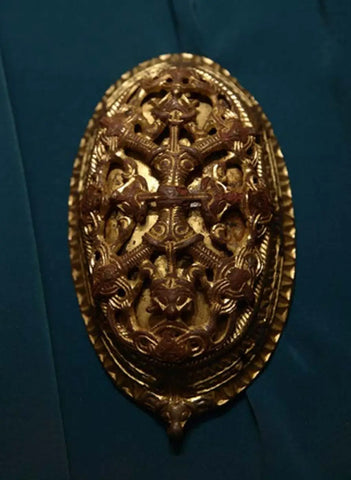
Viking oval brooch. Museum of History, Oslo, Norway.
Rings
Viking Rings, as in most other cultures, were worn around the finger and were extremely popular among the Vikings - there have been numerous findings of rings in Viking grave sites. Viking rings typically had an uneven width, with most of them being open to allow them to be easily adjusted to fit on different sized fingers.
Earrings
Earrings are the least commonly found articles of Viking jewelry. In fact, earrings did not exist in Viking culture until they were found in hoards amongst other types of jewelry. Nordic earrings were quite intricate and, in contrast to modern-day earrings, they would be worn over the entire ear as opposed to hanging from the earlobe. Historians have suggested that Viking earrings were of Slavic in origin and not an original concept forged by the Norsemen.
Arm Rings/Arm Bands
Viking Arm rings or arm bands were extremely popular in Viking culture and, like neck-rings, served the dual purpose of being both ornamental and able to be used in trade. Some arm bands were very intricate and detailed, having been crafted from precious metals such as gold and silver. Arm rings represented societal standing and were a display of wealth.
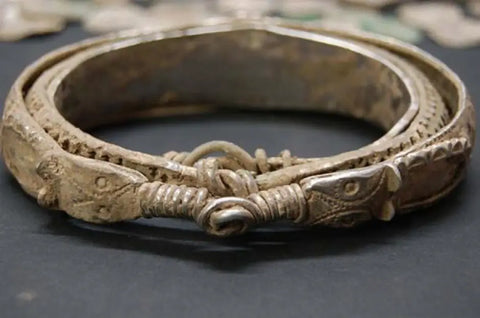
Nested bracelet from the Silverdale Hoard. Image by Ian Richardson.
Viking arm rings bands came in different shapes and designs. Some were spiral, wrapping themselves around the arm several times, giving them a firm grip around the arm, and making it easier for the wearer to tear a piece off the end during a commercial transaction. Other arm rings were only long enough to wrap around three-quarters of the arm and these were the bands most commonly used as currency because they were plain and flat, which made them easier to break apart whenever needed.
In Summary
Vikings enjoyed fashion and the allure of precious metals and they strived to incorporate this into their day-to-day lives by crafting beautiful ornate ornaments as described above. However, unlike most cultures, jewelry pieces in Viking culture typically had a dual purpose, being used both for aesthetic appeal and as a form of currency, much like carrying money in your wallet or purse.
Evidently, Vikings were not the barbarians most people assume they were, they were an organized, sophisticated people with a rich culture that has more in common with most other cultures of their era.
